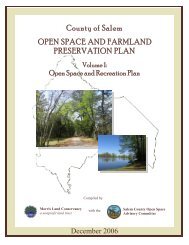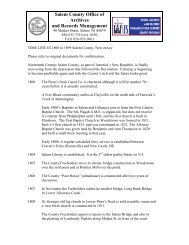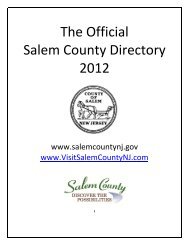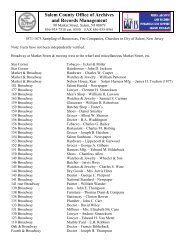Create successful ePaper yourself
Turn your PDF publications into a flip-book with our unique Google optimized e-Paper software.
Board of Chosen Freeholders<br />
SALEM COUNTY DEPARTMENT OF HEALTH<br />
98 Market Street<br />
<strong>Salem</strong>, New Jersey 08079-1995<br />
<strong>Head</strong> <strong>Lice</strong><br />
(PUBLIC HANDOUT)<br />
What are <strong>Head</strong> <strong>Lice</strong>?<br />
<strong>Head</strong> <strong>Lice</strong> are parasitic insects which spend their life cycle in human hair feeding off the<br />
person’s blood. They are smaller than 1/8 inch in length. They are grayish white and<br />
wingless with claws used to cling to hair shafts.<br />
What is a Nit?<br />
A nit is the egg of the head louse which is glued by the mother to the base of the hair<br />
shaft. A female can lay 50-150 eggs in a three- four week period.<br />
Where Can <strong>Head</strong> <strong>Lice</strong> Be Found?<br />
<strong>Head</strong> <strong>Lice</strong> are most commonly found on the scalp above and behind the ears and near the<br />
neck. They have also been found on facial hair, eyebrows and eyelashes of people.<br />
Who Gets <strong>Head</strong> <strong>Lice</strong>?<br />
<strong>Head</strong> <strong>Lice</strong> are found worldwide. In the US, <strong>Head</strong> <strong>Lice</strong> are most common among<br />
preschool & elementary school children as well as the homes of the infested children. An<br />
estimated 6 – 12 million infestations occur each year among children aged 3- 11 years<br />
old.<br />
How is <strong>Head</strong> <strong>Lice</strong> Spread?<br />
<strong>Head</strong> <strong>Lice</strong> is spread by direct head to head contact with someone who has an infestation<br />
of <strong>Head</strong> <strong>Lice</strong>. Contact through clothing (hats, scarves, hair accessories) or personal items<br />
(hair brush, combs, bedding) is uncommon. Personal hygiene and environment<br />
cleanliness are not factors in <strong>Head</strong> <strong>Lice</strong> infestation. Dogs and cats do not play a role in<br />
the spread of human lice.<br />
How Long Can <strong>Head</strong> <strong>Lice</strong> Live Away from the <strong>Head</strong>?<br />
<strong>Head</strong> <strong>Lice</strong> cannot live more than 48 hours with a feeding, therefore once off the head,<br />
they will not survive long. Very few nits will hatch once removed from the head and will<br />
die soon after without a feeding.<br />
What Are the Symptoms of a <strong>Head</strong> <strong>Lice</strong> Infestation (Pediculosis)?<br />
The most common is itching or a tickling feeling of something moving on the scalp.<br />
There can also be irritability and difficulty sleeping because of the movement. Sores and<br />
infection may also develop as a result of scratching.<br />
856-935-7510<br />
856-358-3857<br />
FAX 856-339-0029
Board of Chosen Freeholders<br />
SALEM COUNTY DEPARTMENT OF HEALTH<br />
98 Market Street<br />
<strong>Salem</strong>, New Jersey 08079-1995<br />
<strong>Head</strong> <strong>Lice</strong><br />
(PUBLIC HANDOUT)<br />
How is <strong>Head</strong> <strong>Lice</strong> Diagnosed?<br />
Detection of nits or adult lice through an examination of the scalp is the only way to<br />
confirm a <strong>Head</strong> <strong>Lice</strong> infestation. Because adults are very fast and avoid sunlight<br />
observing nits close to the scalp is the most common way to confirm. Using a magnifying<br />
glass or a fine tooth comb can be helpful to find adults. Nits can often be confused with<br />
other things found in the hair such as hair product and dandruff.<br />
What is the Treatment for <strong>Head</strong> <strong>Lice</strong> Infestation?<br />
<strong>Head</strong> <strong>Lice</strong> infestation can be treated with an over-the-counter or prescription shampoo,<br />
lotion or cream rinse. Treatment failures are common so it is very important to follow the<br />
directions carefully. There is no guarantee that any treatment is going to completely kill<br />
all the eggs, so rechecking the scalp thoroughly every 2-3 days after treatment is<br />
important. Using a nit comb, tweezers, or flea combs and vinegar can help to remove the<br />
nits. This may take many hours over a few days but it is important to remove them all to<br />
prevent re-infestation. If active lice are seen 8-12 hours after treatment, consult with a<br />
doctor for follow-up treatment. A second treatment is usually recommended to kill any<br />
lice that may have hatched from eggs left behind.<br />
*Please note: If your child is 2 years old or under, you should not use medicated lice<br />
treatments. You'll need to remove the nits and lice by hand.<br />
To remove lice and nits by hand:<br />
� Work under a good light, such as the natural sunlight from sitting by a window or<br />
going outdoors. A strong lamp can also be used. If eyesight is a problem, have a<br />
magnifying glass on hand. Nits (lice eggs) are always oval-shaped, usually<br />
grayish-white, although they can vary in color. Nits are generally laid close to the<br />
scalp but can be found anywhere on the hair shaft. Unlike dandruff, which can be<br />
removed easily, nits are attached firmly to the hair shaft.<br />
� Divide the hair in sections and fasten off the hair that is not being worked on at<br />
this time.<br />
� Using a nit removal comb, go through the section of hair from the scalp to the end<br />
of the hair. Use a paper towel to remove any lice, nits, or debris from the comb<br />
between passings. If debris builds up, use an old toothbrush to clean the comb.<br />
� If the lice comb does not remove the nits, then use your fingernails and pull nit<br />
down the length of the hair to remove it.<br />
� Go on to the next section of hair until all sections have been completed.<br />
856-935-7510<br />
856-358-3857<br />
FAX 856-339-0029
Board of Chosen Freeholders<br />
SALEM COUNTY DEPARTMENT OF HEALTH<br />
98 Market Street<br />
<strong>Salem</strong>, New Jersey 08079-1995<br />
<strong>Head</strong> <strong>Lice</strong><br />
(PUBLIC HANDOUT)<br />
What Can Be Done to Prevent the Spread of <strong>Head</strong> <strong>Lice</strong> at Home?<br />
� All those in contact with the infested person should be checked thoroughly for<br />
nits and active lice. This should be done simultaneously for family members they<br />
have been in contact with.<br />
� Family members should avoid sharing combs, brushes, towels and other personal<br />
items just in case.<br />
� Any stray lice or nits on clothing, towels, and bedding will be killed by machine<br />
washing and drying at temperatures over 128 o F.<br />
� Any items that cannot be put through the wash or dry cleaned can be sealed in a<br />
plastic bag for two weeks to kill all lice and nits.<br />
� Combs and brushes can be soaked for an hour in 2% Lysol solution or 120 o F for<br />
10 minutes.<br />
� Since lice to not live long off the head, insecticide spray is not necessary.<br />
� Regular vacuuming will remove any stray lice or nits.<br />
What Can Be Done to Prevent the Spread of <strong>Head</strong> <strong>Lice</strong> at School?<br />
Elementary schools and preschools are primary head to head transmission sites for lice.<br />
Schools should have established protocols for screening children, education of parents<br />
and children, follow-up measures and clear admission and restriction policies in order to<br />
prevent or control an outbreak. Many schools have a “no-nit” rule meaning a child is not<br />
allowed back to school until there are no traces of nits or lice left on the scalp.<br />
856-935-7510<br />
856-358-3857<br />
FAX 856-339-0029












